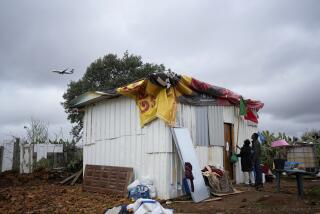Don’t think of Portugal as side trip
Reporting from Lisbon — Travel due east across the Atlantic from New York, and the first country you’ll encounter is Portugal. But it’s often an afterthought for most Americans — a side trip if there’s spare time after visiting Spain, its bigger neighbor.
With its stumbling economy, Portugal has garnered more attention than usual, This is bad news for the Portuguese, of course, but savvy travelers know that bad economies often mean great deals.
Late last spring, my wife and I spent nine nights — but relatively few euros — in Portugal, staying at a variety of distinctive lodgings for a fraction of what comparable accommodations would cost in the U.S. or in much of Europe.
After renting a car in the bustling capital of Lisbon, we headed north to the seaside hamlet of Baleal. Except among surfers, Baleal isn’t nearly as well known as the nearby town of Óbidos, a must-see medieval enclave that’s several miles inland. For us, however, Baleal’s lure was Casa das Marés, a welcoming outpost perched on a narrow spit of land between the craggy Atlantic coast a few steps to the west and a tranquil beach and bay a few steps to the east.
The Casa is one house divided into three bed-and-breakfast establishments. Sisters inherited it and opened separate businesses. If this arrangement sounds ready-made for a reality TV series, forget it. Apparently the three establishments cooperate with one another. Casa das Marés 1, where we had reserved a room, was undergoing renovations when we arrived, but the host on duty quickly found a room for us at Casa das Marés 3, where manager Vitor Laranjeira was soon offering us samples of ginjinha, the Portuguese cherry-flavored liqueur.
Our room overlooked the giant rocks and crashing waves of the ocean, but we ate our breakfast on the sunny eastern porch, facing the calmer beach. All this was for 60 euros, or about $80, which in America would fetch a chain motel room with a view of the parking lot.
The next stop, near the small town of Luso, and our biggest splurge was the Palace Hotel do Bussaco, a hilltop castle built as a royal retreat in 1885 with intricate ornamentation. It’s surrounded by 250 acres of forest that includes rare botanical samples from around the world. Crisscrossing trails lead to fountains, ruined chapels and views of the surrounding valleys. Lonely Planet lists the hotel restaurant as one of Portugal’s top five, and we ate a sumptuous multicourse meal under its high ceilings, which we worked off by hiking around the grounds the next morning.
The room was 120 euros, or about $166 — 30 euros less than the lowest rate mentioned in the guidebook. Prices included a buffet breakfast in the same splendid dining room. But after our stay here in a relatively busy season, I noticed midweek winter rates as low as 80 euros on the hotel’s website. In other words, at Bussaco, you can live like a prince at a price that might interest an upwardly mobile pauper.
Not far from Bussaco, we stayed at a pousada in the small city of Viseu in north-central Portugal. Pousadas are the Portuguese equivalent of the Spanish paradores — government-owned and -operated hotels, usually in historic or landmark structures. After visiting https://www.pousadas.com, I couldn’t resist a stay in Viseu’s pousada for 50 euros, or about $69. The promotional rate marked the first anniversary of the conversion of a 19th century hospital into this ultra-modern hotel.
The building still looks 19th century from the outside. Inside, the corridors surround an airy covered courtyard, which features an indoor-outdoor restaurant. The guest rooms are very 21st century, as are the indoor spa and outdoor pool. Walk north from the hotel entrance, and within five minutes you’re in the city center. About an hour east of Viseu is Portugal’s largest protected area, Parque Natural da Serra da Estrela, where the highest point in Portugal, 6,539-feet-high Torre, offers skiing in the winter.
After a swing through northwestern Spain, we reentered Portugal from the east and stopped in Évora, a magnificently preserved city where we stayed at the U.S.-affiliated Best Western Hotel Santa Clara, for 60 euros, or about $83, a night. I was relieved to find that it was not a generic motel near an interstate but situated on a narrow alley in the ancient district near the town’s central plaza. We soaked up Old World atmosphere within a few blocks of our doorstep, then drove west to the much older Cromeleque dos Almendres, a collection of big stones, arranged 2,000 years before Stonehenge.
Then it was on to the southern Algarve region. We avoided the developed beach resorts, choosing instead to stay a few minutes inland at Duas Quintas, a beguiling bed-and-breakfast in a converted farmhouse surrounded by rolling hills and fields. Our British expat hosts, the Cave family, charged 65 euros, or about $90, which included written directions for walks through the countryside and expert advice about restaurants in the nearby medieval town of Silves.
Three hours after leaving rural byways, we were in the heart of Lisbon, where the hills, cable cars and bridges are reminiscent of San Francisco’s. For our final Portuguese lodging, we spent 85 euros, or $117, for Casa Costa do Castelo, a bed-and-breakfast clinging to a hillside with astonishing views of the city. From the Casa, we walked up the cobblestoned hillside to one of Portugal’s most popular attractions, the ancient Castelo de São Jorge, where the ramparts offer spectacular vistas in even more directions.
We stayed in cities big and small, on the coast, on a hilltop and at a farm — all at bargain-basement rates within a relatively compact country. For us, Spain now is definitely the side trip.
More to Read
Sign up for The Wild
We’ll help you find the best places to hike, bike and run, as well as the perfect silent spots for meditation and yoga.
You may occasionally receive promotional content from the Los Angeles Times.






